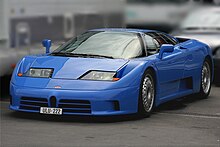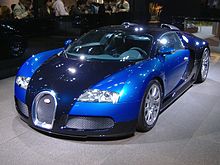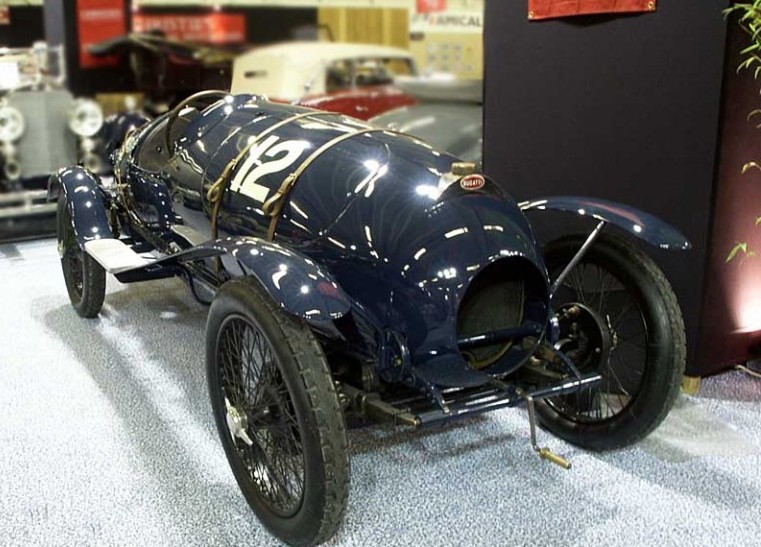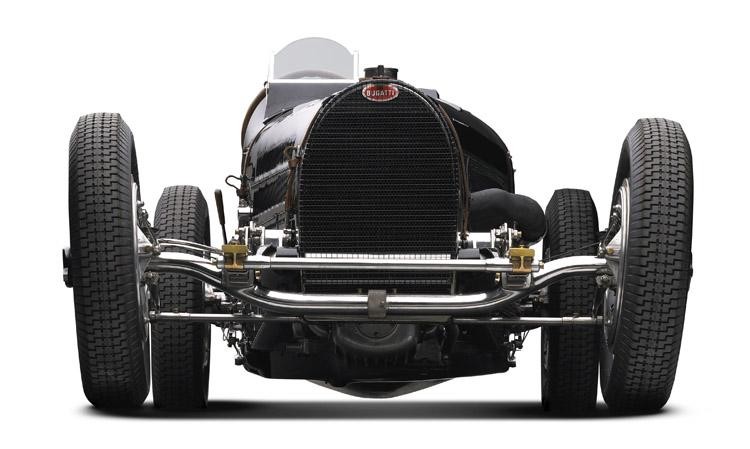
Bugatti


The Bugatti logo
|
|
|
Former type
|
Private |
|---|---|
| Industry | Automotive |
| Fate | Sold to Hispano-Suiza (1963) Sold to Volkswagen Group (July 1998) |
| Successor | Bugatti Automobiles S.A.S. |
| Founded | 1909 |
| Founder | Ettore Bugatti |
| Defunct | 1963 |
| Headquarters | Molsheim, Alsace, France |
|
Key people
|
|
| Products | Automobiles |
| Website |
|
Automobiles Ettore Bugatti was a French car manufacturer of high-performance automobiles, founded in 1909 in the then German city of Molsheim, Alsace by Italian-born Ettore Bugatti.
Bugatti cars were known for their design beauty (Ettore Bugatti was from a family of artists and considered himself to be both an artist and constructor) and for their many race victories. Famous Bugattis include the Type 35 Grand Prix cars, the Type 41 "Royale", the Type 57 "Atlantic" and the Type 55 sports car.
The death of Ettore Bugatti in 1947 proved to be the end for the marque, and the death of his son Jean Bugatti in 1939 ensured there was not a successor to lead the factory. No more than about 8,000 cars were made. The company struggled financially, and released one last model in the 1950s, before eventually being purchased for its airplane parts business in the 1960s.
In the 1990s, an Italian entrepreneur revived it as a builder of limited production exclusive sports cars. Today, the name is owned by German automobile manufacturing group Volkswagen.
Under Ettore Bugatti
Founder Ettore Bugatti was born in Milan, Italy, and the automobile company that bears his name was founded in 1909 in Molsheim located in the Alsace region which was part of the German Empire from 1871 to 1919. The company was known both for the level of detail of its engineering in its automobiles, and for the artistic manner in which the designs were executed, given the artistic nature of Ettore's family (his father, Carlo Bugatti (1856–1940), was an important Art Nouveau furniture and jewelry designer).
World War I and its aftermath
During the war Ettore Bugatti was sent away, initially to Milan and later to Paris, but as soon as hostilities had been concluded he returned to his factory at Molsheim. Less than four months after the Versailles Treaty formalised the transfer of Alsace from Germany to France, Bugatti was able to obtain, at the last minute, a stand at the 15th Paris motor show in October 1919. He exhibited three light cars, all of them closely based on their pre-war equivalents, and each fitted with the same overhead camshaft 4-cylinder 1,368cc engine with four valves per cylinder. Smallest of the three was a "Type 13" with a racing body (constructed by Bugatti themselves) and using a chassis with a 2,000 mm (78.7 in) wheelbase. The others were a "Type 22" and a "Type 23" with wheelbases of 2,250 and 2,400 mm (88.6 and 94.5 in) respectively.
Racing successes
The company also enjoyed great success in early Grand Prix motor racing: in 1929 a privately entered Bugatti won the first ever Monaco Grand Prix. Racing success culminated with driver Jean-Pierre Wimille winning the 24 hours of Le Mans twice (in 1937 with Robert Benoist and 1939 with Pierre Veyron).
Bugatti cars were extremely successful in racing. The little Bugatti Type 10 swept the top four positions at its first race. The 1924 Bugatti Type 35 is probably the most successful racing car of all time, with over 2,000 wins.[citation needed] The Type 35 was developed by Bugatti with master engineer and racing driver Jean Chassagne who also drove it in the car’s first ever Grand Prix in 1924 Lyon. Bugattis swept to victory in the Targa Florio for five years straight from 1925 through 1929. Louis Chiron held the most podiums in Bugatti cars, and the modern marque revival Bugatti Automobiles S.A.S. named the 1999 Bugatti 18/3 Chiron concept car in his honour. But it was the final racing success at Le Mans that is most remembered—Jean-Pierre Wimille and Pierre Veyron won the 1939 race with just one car and meagre resources.
Aeroplane racing
In the 1930s, Ettore Bugatti got involved in the creation of a racer airplane, hoping to beat the Germans in the Deutsch de la Meurthe prize. This would be the Bugatti 100P, which never flew. It was designed by Belgian engineer Louis de Monge who had already applied Bugatti Brescia engines in his "Type 7.5" lifting body.
Railcar
Ettore Bugatti also designed a successful motorised railcar, the Autorail Bugatti (Autorail Bugatti).
Family tragedy
The death of Ettore Bugatti's son, Jean Bugatti, on 11 August 1939 marked a turning point in the company's fortunes. Jean died while testing a Type 57 tank-bodied race car near the Molsheim factory.
After World War II
World War II left the Molsheim factory in ruins and the company lost control of the property. During the war, Bugatti planned a new factory at Levallois, a northwestern suburb of Paris. After the war, Bugatti designed and planned to build a series of new cars, including the Type 73 road car and Type 73C single seat racing car, but in all Bugatti built only five Type 73 cars.
Development of a 375 cc supercharged car was stopped when Ettore Bugatti died on 21 August 1947. Following Ettore Bugatti's death, the business declined further and made its last appearance as a business in its own right at a Paris Motor Show in October 1952.
After a long decline, the original incarnation of Bugatti ceased operations in 1952.
Design
Bugattis are noticeably focused on design. Engine blocks were hand scraped to ensure that the surfaces were so flat that gaskets were not required for sealing, many of the exposed surfaces of the engine compartment featured guilloché (engine turned) finishes on them, and safety wires had been threaded through almost every fastener in intricately laced patterns. Rather than bolt the springs to the axles as most manufacturers did, Bugatti's axles were forged such that the spring passed though a carefully sized opening in the axle, a much more elegant solution requiring fewer parts. He famously described his arch competitor Bentley's cars as "the world's fastest lorries" for focusing on durability. According to Bugatti, "weight was the enemy".
Important models built
| Prototypes | Racing cars | Road cars |
|---|---|---|
|
|
|
Gallery
-
1913 Bugatti 22, 3 seat Vinet
-

1938 Type 57SC Atlantic from the Ralph Lauren collection
-

1933 Type 59 Grand Prix racer from the Ralph Lauren collection
Notable finds in the modern era
Relatives of Harold Carr found a rare 1937 Bugatti Type 57S Atalante when cataloguing the doctor's belongings after his death in 2009. Carr's Type 57S is notable because it was originally owned by British race car driver Earl Howe. Because much of the car's original equipment is intact, it can be restored without relying on replacement parts.
On 10 July 2009, a 1925 Bugatti Brescia Type 22 which had lain at the bottom of Lake Maggiore on the border of Switzerland and Italy for 75 years was recovered from the lake. The Mullin Museum in Oxnard, California bought it at auction for $351,343 at Bonham's Rétromobile sale in Paris in 2010.
Attempts at revival
The company attempted a comeback under Roland Bugatti in the mid-1950s with the mid-engined Type 251 race car. Designed with help from Gioacchino Colombo, the car failed to perform to expectations and the company's attempts at automobile production were halted.
In the 1960s, Virgil Exner designed a Bugatti as part of his "Revival Cars" project. A show version of this car was actually built by Ghia using the last Bugatti Type 101 chassis, and was shown at the 1965 Turin Motor Show. Finance was not forthcoming, and Exner then turned his attention to a revival of Stutz.
Bugatti continued manufacturing airplane parts and was sold to Hispano-Suiza, also a former auto maker turned aircraft supplier, in 1963. Snecma took over Hispano-Suiza in 1968. After acquiring Messier, Snecma merged Messier and Bugatti into Messier-Bugatti in 1977.
Modern revivals
Bugatti Automobili S.p.A. (1987–1995)


Italian entrepreneur Romano Artioli acquired the Bugatti brand in 1987, and established Bugatti Automobili S.p.A.. Artioli commissioned architect Giampaolo Benedini to design the factory which was built in Campogalliano, Modena, Italy. Construction of the plant began in 1988, alongside the development of the first model, and it was inaugurated two years later—in 1990.
By 1989 the plans for the new Bugatti revival were presented by Paolo Stanzani and Marcello Gandini, designers of the Lamborghini Miura and Lamborghini Countach. The first production vehicle was the Bugatti EB110 GT. It used a carbon-fibre-reinforced polymer chassis, a 3.5-litre, 5-valve per cylinder, quad-turbocharged 60° V12 engine, a six-speed gearbox, and four-wheel drive.
Famed racing car designer Mauro Forghieri served as Bugatti's technical director from 1992 through 1994.
On 27 August 1993, through his holding company, ACBN Holdings S.A. of Luxembourg, Romano Artioli purchased Lotus Cars from General Motors. Plans were made to list Bugatti shares on international stock exchanges.
Bugatti presented a prototype large saloon called the EB112 in 1993.
Perhaps the most famous Bugatti EB110 owner was seven-time Formula One World Champion racing driver Michael Schumacher who purchased an EB110 in 1994. Schumacher sold his EB110, which had been repaired after a severe 1994 crash, to Modena Motorsport, a Ferrari service and race preparation garage in Germany.
By the time the EB110 came to market, the North American and European economies were in recession. Poor economic conditions forced the company to fail and operations ceased in September 1995. A model specific to the US market called the "Bugatti America" was in the preparatory stages when the company ceased operations.
Bugatti's liquidators sold Lotus Cars to Proton of Malaysia. German firm Dauer Racing purchased the EB110 licence and remaining parts stock in 1997 in order to produce five more EB110 SS vehicles. These five SS versions of the EB110 were greatly refined by Dauer. The Campogalliano factory was sold to a furniture-making company, which subsequently collapsed before moving in, leaving the building unoccupied. After Dauer stopped producing cars in 2011, Toscana-Motors GmbH of Germany purchased the remaining parts stock from Dauer.
Bugatti Automobiles S.A.S. (1998–present)
 The Bugatti Logo |
|
| Type | Private Société par actions simplifiée |
|---|---|
| Industry |
|
| Fate | purchased by Volkswagen AG (July 1998) |
| Predecessor | Bugatti Automobili S.p.A. |
| Founded | July 1998; 18 years ago (1998-07) |
| Headquarters | Molsheim, France |
| Area served | Worldwide (except Australia) |
| Key people | Wolfgang Dürheimer (President) |
| Products | Bugatti Chiron |
| Parent | Volkswagen AG |
| Subsidiaries |
|
| Website | bugatti |
Bugatti Automobiles S.A.S. is a French high-performance luxury automobiles manufacturer and a subsidiary of Volkswagen AG, with its head office and assembly plant in Molsheim, Alsace, France. Volkswagen purchased the Bugatti trademark in June 1998 and incorporated Bugatti Automobiles S.A.S. in 1999.
Bugatti presented several concept cars between 1998 and 2000 before commencing development of its first production model, the Veyron 16.4, delivering the first Veyron to a customer in 2005.
History
At the urging of then-chairman Ferdinand Piëch, Volkswagen purchased the rights to produce cars under the Bugatti marque in June 1998. This followed the earlier Volkswagen purchases of the Lamborghini marque (by VW's Audi subsidiary), the Rolls-Royce factory in Crewe, United Kingdom, and the Bentley marque.
On 22 December 2000, Volkswagen officially incorporated Bugatti Automobiles S.A.S., with former VW drivetrain chief Karl-Heinz Neumann as president. The company purchased the 1856 Château Saint Jean, formerly Ettore Bugatti's guest house in Dorlisheim, near Molsheim, and began refurbishing it to serve as the company's headquarters. The original factory was still in the hands of Snecma, who were unwilling to part with it. At the Pebble Beach Concours d'Elegance in August 2000, VW announced that they would instead build a new modern atelier (factory) next to and south of the Château. The atelier was officially inaugurated on 3 September 2005.
Bugatti Automobiles S.A.S. is a wholly owned subsidiary of the Volkswagen AG
After the Veyron's discontinuation in 2014, the new Bugatti model was revealed to be the Chiron in 2016. With an 8-liter W16 engine delivering 1500 horse power and an electronically limited top speed of 260 miles per hour and a price of about €2,400,000, the Chiron attempts to vastly surpass the Veyron's performance.
Concept cars
Italdesign Giugiaro designs
Volkswagen commissioned Italdesign's Giorgetto Giugiaro to design a series of concept cars to return the marque to prominence. The first example, the EB 118, was a two-door coupé and was introduced at the Paris Motor Show in 1998. It was followed by the four-door EB 218 touring sedan, introduced at the Geneva Motor Show in 1999. Later that year, the 18/3 Chiron was shown at the IAA in Frankfurt.
Volkswagen designs
Volkswagen designed the final Bugatti concept, the EB 18/4 GT in house. Bugatti introduced the EB 18/4 at the 1999 Tokyo Motor Show.
W18 Engine
All of these early concepts featured a 555 PS (408 kW; 547 hp) 18-cylinder engine. This was the first-ever W-configuration engine on a passenger vehicle, with three blocks of 6 cylinders each. It shared many components with Volkswagen's modular engine family.
16C Galibier
Main article: Bugatti 16C Galibier
The 16C Galibier was first unveiled during Celebration of the Centenary of the Marque in Molsheim. The presentation was only for Bugatti customers. The car show in Molsheim showed the car in blue carbon fibre and aluminum parts. One year later Bugatti showed the world the 16C Galibier Concept at "VW Group Night" at the Geneva Auto Show in a new black and aluminum color combination.
The Galibier, a 1000 HP sedan, was first shown as a concept in 2010 and when they planned to put it into production in 2015, It would have cost about $1.4 million. It would use the same 16-cylinder 8.0-litre engine as the Veyron but instead of four turbos, the 16C Galibier would instead use two superchargers to deliver better torque. Production would require new facilities in Molsheim, France, to be refitted, which pushed back potential deliveries until 2015.
In 2013 it was announced that the car will never be produced as they wish to focus on a Veyron replacement.
Production cars

Bugatti EB110 GT
In the 1980s the Bugatti brand was brought back as Bugatti Automobili S.p.A. in Italy. The company produced the EB110 in the 1990s, which put Bugatti back on the modern super-car scene. The company was then bought by VW at the end of the 20th century.
Veyron 16.4
Main article: Bugatti Veyron

Veyron 16.4
Development of this vehicle began with the 1999 EB 18/4 "Veyron" concept car, which itself had a chassis based on that of the Bugatti 18/3 Chiron concept car. It was similar in design and appearance to the final Veyron production car. One major difference was the EB 18/4's use of a W18 engine with three banks of six cylinders. The Veyron's chief designer was Hartmut Warkuss, and the exterior was designed by Jozef Kabaň of Volkswagen, rather than Giorgetto Giugiaro of Italdesign, who had handled the three prior Bugatti concepts.
The then – Volkswagen Group chairman Ferdinand Piëch announced the Veyron at the 2000 Geneva Motor Show. It was promised to be the fastest, most powerful and most expensive car in history. Instead of the W18, it would use a VR6/WR8-style W16 engine. First seen in the 1999 Bentley Hunaudières concept car, the W16 would have four turbochargers and produce a quoted (metric) 1001 horsepower (see engine section for details on the power output). Top speed was promised at 407 km/h (253 mph), and the price was announced at €1 million.
Development continued throughout 2001 and the EB 16/4 Veyron was promoted to "advanced concept" status. In late 2001, Bugatti announced that the car, officially called the "Bugatti Veyron 16.4", would go into production in 2003.
Piëch retired that year as chairman of the Volkswagen Group and was replaced by Bernd Pischetsrieder. The new chairman promptly sent the Veyron back to the drawing board for major revisions. Neumann was replaced as Bugatti president by Thomas Bscher in December 2003, and substantial modifications were made to the Veyron under the guidance of a former VW engineer, Bugatti Engineering chief Wolfgang Schreiber.
The Veyron costs €1,100,000 (net price without taxes);[citation needed] prices vary by exchange rates and local taxes (like value added taxes). Prices for the UK or the US are over £880,000, or around $1,400,000. It was noted in an April issue of Live magazine (weekly men's magazine with The Sunday Times) that customers are free to order additional extras which can push the price up by the cost of a Rolls Royce Phantom. During an episode of Top Gear, the car was compared to the Concorde as a feat of technology.
Chiron
At the 2016 Geneva Auto Show, Bugatti premiered the Bugatti Chiron as a successor to the Veyron. The pricing is set at 2.4 million euros. The car is expected to have 1500 horsepower and will be capped at 420 km/h (260 mph) for road use. It can accelerate from 0-100 km/h in 2.5 seconds. Production is limited to 500 units. Unlike the Veyron, the Chiron is expected to make a profit.
Pre-Veyron

Volkswagen AG acquired the Bugatti brand in 1998. Bugatti Automobiles S.A.S. commissioned Giorgetto Giugiaro of ItalDesign to produce Bugatti Automobiles's first concept vehicle, the EB118, a coupé that debuted at the 1998 Paris Auto Show. The EB118 concept featured a 408-kilowatt (555 PS; 547 bhp), W-18 engine. After its Paris debut, the EB118 concept was shown again in 1999 at the Geneva Auto Show and the Tokyo Motor Show. Bugatti introduced its next concepts, the EB 218 at the 1999 Geneva Motor Show and the 18/3 Chiron at the 1999 Frankfurt Motor Show (IAA).
Veyron era (2005-2015)
Bugatti Automobiles S.A.S. began assembling its first regular-production vehicle, the Bugatti Veyron 16.4 (the 1001 BHP super car with an 8-litre W-16 engine with four turbochargers) in September 2005 at the Bugatti Molsheim, France assembly "studio". On 23 February 2015, Bugatti sold its last Veyron Grand Sport Vitesse, which was named La Finale.
Chiron era (2016-present)
The Bugatti Chiron is a mid-engined, two-seated sports car, designed by Achim Anscheidt, developed as the successor to the Bugatti Veyron. The Chiron was first revealed at the Geneva Motor Show on March 1, 2016.








































